Self-Portraits
© Thomas Wilson Shawcross 25 Mar 2006
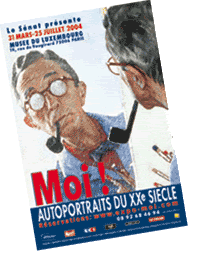
Museum of Luxembourg 31 March – 25 July 2004 ME! Self-portraits of the 20th century
Last weekend, to celebrate the start of my son Michael’s Spring Break, we went to DisneyWorld, where we saw this Mickey Mouse Self-Portrait:

I thought this was a clever painting. After all, Walt Disney was the originator of the cartoon character Mickey Mouse and Walt’s voice was used for all of Mickey’s cartoon dialogues until 1946. How appropriate to have Mickey paint his self-portrait in the image of Walter Elias Disney!
Of course, this might have been an Oswald Rabbit Self-Portrait if Disney had not been cheated out of the rights to his Oswald Rabbit character by Universal Studios. Is it just me, or is there more than a casual resemblance between 1927 Oswald and 1928 Mickey?
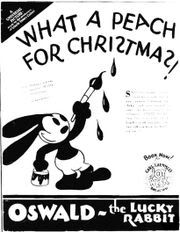
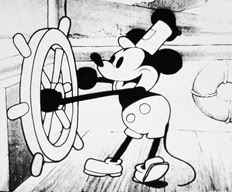
But beyond being impressed by the cleverness of the Mickey / Disney self-portrait, I was struck by the realization that I was seeing another example of art parody – something that I had written about last month in my story Nighthawks and Night Hogs. In yet another spooky coincidence, on the preceding evening at Disney Village, I had purchased a Tom Waits CD titled Nighthawks at the Diner.
The Mickey Mouse Self-Portrait is a parody of the Norman Rockwell Triple Self-Portrait that appeared on the cover of the 13 Feb 1961 Saturday Evening Post. Rockwell’s image made a strong impression on me when I had seen it on the magazine cover in 1961, and subsequently I had the good fortune of seeing his original painting at the Norman Rockwell museum in Stockbridge, Massachusetts.
My impression in 1961 was that Norman Rockwell was trying to show that he was a true artist, not a mere illustrator, as his painting included postcard-sized self-portraits that had been made by recognized great artists. It strikes me as unfair that illustrators and commercial artists seem to be considered by some as second-class citizens in the Art World. I suppose it is related to the distinction made between arts and crafts, and the difference may be in the degree of creativity or originality or talent supposedly involved. But in my opinion, this is a grossly unfair and misleading distinction, as some of our most memorable and striking images have been created by great artists for commercial purposes (think Maxfield Parrish, Norman Rockwell, and David Lance Goines).
As Mike and I stood at Epcot, looking at Mickey Mouse Self-Portrait, I thought of how original Norman Rockwell’s self-portrait had been – and that gave me the idea of writing about self-portraits.

Here is an excerpt from the website of the Norman Rockwell Museum:
Source: http://www.nrm.org/eyeopener/eye_self.html
“Throughout art history, artists have explored the idea of the self-portrait. Norman Rockwell admired the work of other artists, among them Durer, Rembrandt, Picasso, and Van Gogh. Their self-portraits are tacked to Rockwell's canvas for inspiration . . . While Rockwell painted many self-portraits over the years, this one, done when the artist was 66 years old, is the most famous.
This self-portrait gives a glimpse into Rockwell's life: a glass of Coca-Cola, a dog-eared book and a metal bucket with a bit of smoke. This last detail probably refers to Norman Rockwell's Vermont studio fire in 1943. Describing this fire with sketches in his autobiography, Rockwell said, "In a way the fire was a good thing. It cleaned out the cobwebs.”
I think the writer of the above excerpt under-estimated the significance of the Dürer, Rembrandt, Picasso, and Van Gogh self-portraits. I suspect Rockwell was showing his knowledge of Art History by including works of these artists in his triple self-portrait, and that he was suggesting that he too was an Artist (not a mere Illustrator).
Rockwell’s triple self-portrait displays much more than his background in art history. It tells us much about him. For one thing, it shows his sense of humor in painting himself as he really looked (in the mirror and sitting on the stool) while also showing an idealized “glamour shot” of himself without glasses and his pipe jauntily cocked.
We see not only the self-image (typically expected) in self-portraits. We see objects that tell us about the personal life and views of the artist. Look at this painting from the standpoint of wondering what each object may have meant to Norman Rockwell. Note that the background of the painting is white – he did not paint the room he was in – he painted only the objects he wanted us to see, so each of them has significance.
I suspect the paint brushes on the “floor” are there to provide the illusion that there was a floor (that he was not suspended in space as he painted this), but note their placement as well – they lead the eye to the stool and from there on up to Norman Rockwell himself.
Rockwell was a master of using objects to “lead the eye.” Note how the pole on which he rested his arm while painting leads your eye to the self-portraits done by Dürer and Rembrandt. See how his paint brushes lead the eye to his image in the mirror, how the mirror image of the palette leads the eye to the glass of Coke (and how that helps suggest one of the many triangle images in this composition of multiple rectangles and triangles).
Other objects in the painting do not serve so much to “lead the eye” as they do to give clues to the interests of the artist. Consider that the glass of Coca-Cola, the book, even the American Federalist style mirror, were chosen to be in this self-portrait. I do not pretend to know what each object meant to Norman Rockwell. Did he drink Coca-Cola while painting? Did he refer to Art History books for inspiration? I have no idea what was the significance of the golden helmet atop the easel, but it might refer to another Rembrandt painting. As for the metal bucket with smoke coming up from it, what did the bucket symbolize? The website suggests that the smoke may have referenced the 1943 fire in Rockwell’s studio, but why was there a smoking bucket in 1961? Did Rockwell use a metal bucket as an “ashtray” for his pipe? At any rate, the placement of the smoke wisp does help the overall composition.
The painting within the painting of his in-progress idealized image has already been “signed” by Norman Rockwell. I suspect that Rockwell usually signed his paintings when they were completed, so this seeming “blooper” is actually a visual double entendre, because the image of the unfinished idealized painting is part of the finished work of art.
Rockwell provides revealing glimpses of how he painted – the previously mentioned pole on which he rested his hand while painting, and the five preliminary self-sketches that are tacked to the upper left corner of the painting. But even more revealing are the pictures in the upper right corner of his painting – the self-portraits done by other artists.
The first painting in the upper right is of a self-portrait done by Albrecht Dürer. Albrecht painted this in 1498 when he was 26 years old. I have seen it in Madrid at the Museo Nacional del Prado:
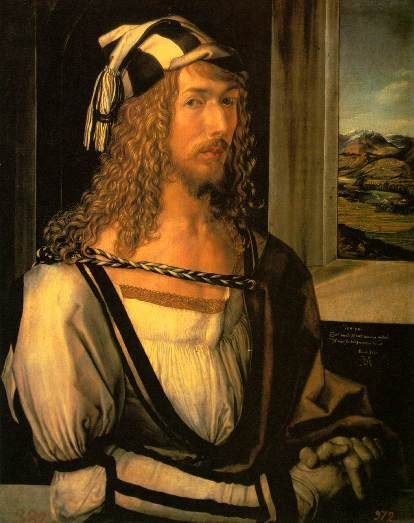
Albrecht Dürer (1471-1528) was one of our greatest artists and is recognized as being the first artist to consistently create self-portraits. In doing so, he elevated self-portraits to the level of being considered works of art. He created his first self-portrait at the age of 13. By including a Dürer self-portrait, Rockwell was acknowledging the artist who granted artistic legitimacy to self-portraits.
Rembrandt van Rijn (1606-1669) is recognized as the first artist to intensely study the self through the art of self-portraiture. He sketched his own face literally thousands of times, throughout his lifetime. I have seen many of his self-portraits, and on a side note, I cannot help but wonder if Rembrandt shopped in the remainder bins of stores that sold clothing to pirates.

Rembrandt van Rijn Self-portrait, 1661
In the pantheon of self-portraiture, Vincent Van Gogh (1853-1890) is as noted as Rembrandt, even though Vincent painted most of his self-portraits during only two years of his life (1886-1888). His 1889 self-portraits seem especially revealing of his troubled psyche(the bandaged head image was painted after his self-mutilation).
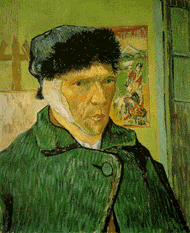
Self-Portrait with Bandaged Head (1889)
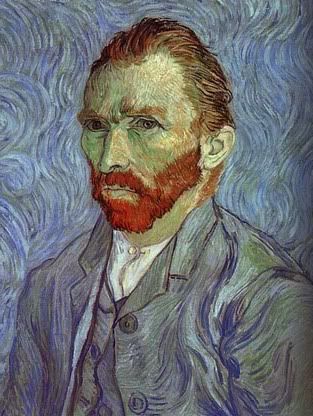
Self-Portrait (1889)
Pablo Picasso (1881-1973) was another innovator in self-portraiture. He painted himself in several artistic styles. His earliest self-portraits (1900-1901) were, like those of Rembrandt and Van Gogh, images in which he stared at the viewer and revealed himself through his expression. He also painted himself during his Cubist period and his Blue Period, but perhaps his most innovative approach was in the late 1930’s, when he painted himself by showing front and side views within the same picture:
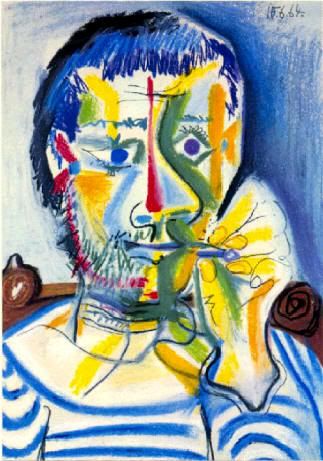
Self-Portrait
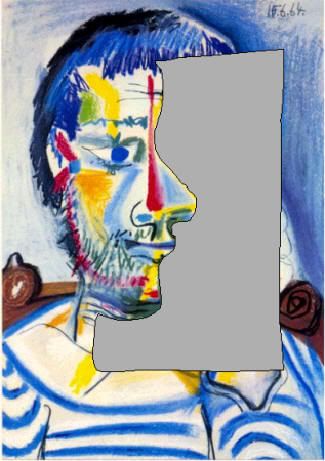
(grayed area to show side-view)
Self-portraits can have many meanings. They have been made to project how an artist wishes to be seen, or for doing a study of oneself, to help remember the past, to reveal emotions, or maybe just because an artist could not afford to pay for a model.
Sometimes, they are done to test a new technique. Leonardo Da Vinci, another innovator in self-portraiture, was the first to attempt to make three-dimensional-looking portraits, using the sfumato drawing technique in which the image softens as it recedes from the viewer, and there are no hard outlines.
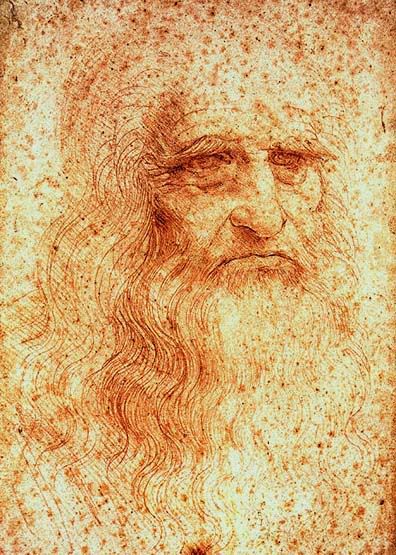
Self-portrait, Leonardo Da Vinci 1525 (red chalk)
Gustave Courbet (1819-1877) was another innovator. Beyond painting his own self-likeness, he created fantasy scenes that represented aspects, real and symbolic, of his life. In his celebrated Interior of My Studio, A Real Allegory Summing Up Seven Years of My Life as an Artist Courbet depicts not only himself at his easel, but also symbolic characters (the nude model is thought to represent Nature, and the small boy represents Innocence) and real characters (Baudelaire is shown reading a book).
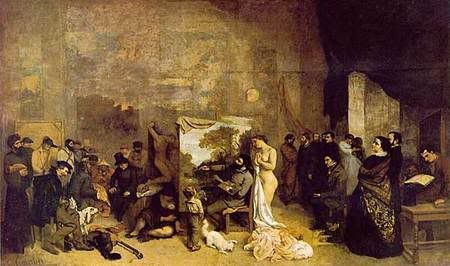
Interior of My Studio, A Real Allegory Summing Up Seven Years of My Life as an Artist (1854-1855)
Gustave Courbet
Frida Kahlo (1907-1954) told her life story in her self-portraits and used them as a kind of therapy for a leg that was crippled by polio and permanent injuries that she suffered in a bus accident that hospitalized her for months. Frida’s mother had a mirror installed above Frida’s bed, and Frida started painting self-portraits. During the remainder of her life, she painted 55 of them. I particularly like the genealogical one shown here:
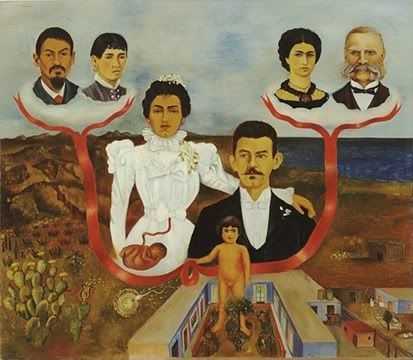

Self-portraits have gone far beyond capturing a literal likeness of the artist. They embody self-exploration, looking beyond the image presented in the mirror. Abstract self-portraits, such as those done by Pollack or Rothko, do not bear any resemblance to the human form. Others, such as Chagall’s I and the Village, are memoirs that do not resemble the artist:
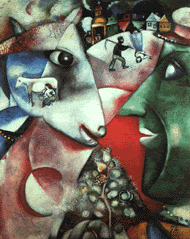
Marc Chagall I and the Village (1911)
One of the more innovative self-portrait artists of recent times is Chuck Close. He has gone from extreme realism to techno-reality:
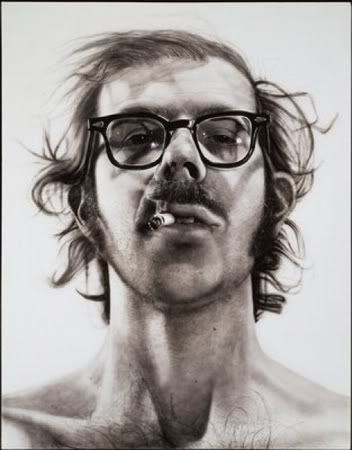
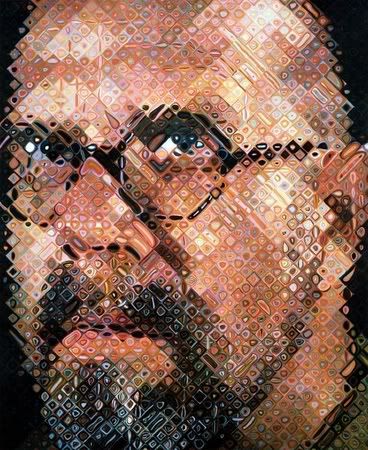
How many ways of depicting oneself have yet to be invented? In this story, I have shown and discussed only a few. I have not even hinted at some of the other options, such as these self-portraits painted by Renee Magritte (1898-1967):
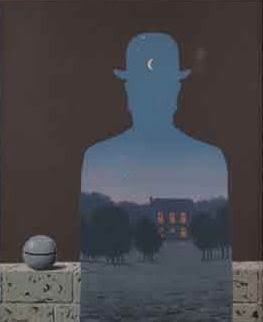
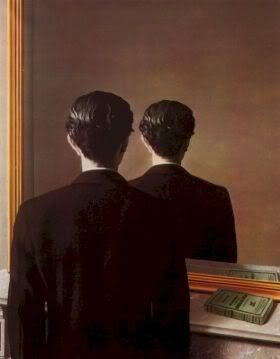
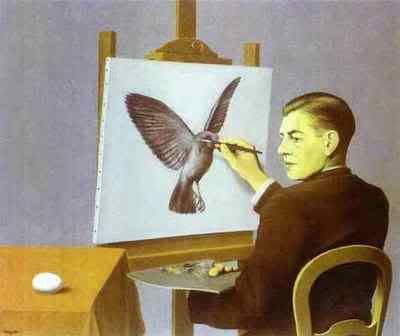
If you had the artistic ability to paint your self-portrait, in any imaginable style, what would you do? Would you make yet another parody of a famous work of art?
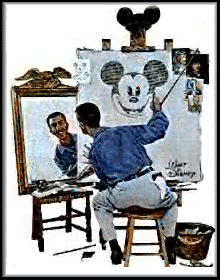
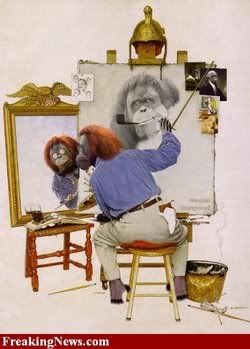
Or would you choose a new way to give insight to your life experiences, your world-view, and the essence that is uniquely you?

Museum of Luxembourg 31 March – 25 July 2004 ME! Self-portraits of the 20th century
Last weekend, to celebrate the start of my son Michael’s Spring Break, we went to DisneyWorld, where we saw this Mickey Mouse Self-Portrait:

I thought this was a clever painting. After all, Walt Disney was the originator of the cartoon character Mickey Mouse and Walt’s voice was used for all of Mickey’s cartoon dialogues until 1946. How appropriate to have Mickey paint his self-portrait in the image of Walter Elias Disney!
Of course, this might have been an Oswald Rabbit Self-Portrait if Disney had not been cheated out of the rights to his Oswald Rabbit character by Universal Studios. Is it just me, or is there more than a casual resemblance between 1927 Oswald and 1928 Mickey?


But beyond being impressed by the cleverness of the Mickey / Disney self-portrait, I was struck by the realization that I was seeing another example of art parody – something that I had written about last month in my story Nighthawks and Night Hogs. In yet another spooky coincidence, on the preceding evening at Disney Village, I had purchased a Tom Waits CD titled Nighthawks at the Diner.
The Mickey Mouse Self-Portrait is a parody of the Norman Rockwell Triple Self-Portrait that appeared on the cover of the 13 Feb 1961 Saturday Evening Post. Rockwell’s image made a strong impression on me when I had seen it on the magazine cover in 1961, and subsequently I had the good fortune of seeing his original painting at the Norman Rockwell museum in Stockbridge, Massachusetts.
My impression in 1961 was that Norman Rockwell was trying to show that he was a true artist, not a mere illustrator, as his painting included postcard-sized self-portraits that had been made by recognized great artists. It strikes me as unfair that illustrators and commercial artists seem to be considered by some as second-class citizens in the Art World. I suppose it is related to the distinction made between arts and crafts, and the difference may be in the degree of creativity or originality or talent supposedly involved. But in my opinion, this is a grossly unfair and misleading distinction, as some of our most memorable and striking images have been created by great artists for commercial purposes (think Maxfield Parrish, Norman Rockwell, and David Lance Goines).
As Mike and I stood at Epcot, looking at Mickey Mouse Self-Portrait, I thought of how original Norman Rockwell’s self-portrait had been – and that gave me the idea of writing about self-portraits.

Here is an excerpt from the website of the Norman Rockwell Museum:
Source: http://www.nrm.org/eyeopener/eye_self.html
“Throughout art history, artists have explored the idea of the self-portrait. Norman Rockwell admired the work of other artists, among them Durer, Rembrandt, Picasso, and Van Gogh. Their self-portraits are tacked to Rockwell's canvas for inspiration . . . While Rockwell painted many self-portraits over the years, this one, done when the artist was 66 years old, is the most famous.
This self-portrait gives a glimpse into Rockwell's life: a glass of Coca-Cola, a dog-eared book and a metal bucket with a bit of smoke. This last detail probably refers to Norman Rockwell's Vermont studio fire in 1943. Describing this fire with sketches in his autobiography, Rockwell said, "In a way the fire was a good thing. It cleaned out the cobwebs.”
I think the writer of the above excerpt under-estimated the significance of the Dürer, Rembrandt, Picasso, and Van Gogh self-portraits. I suspect Rockwell was showing his knowledge of Art History by including works of these artists in his triple self-portrait, and that he was suggesting that he too was an Artist (not a mere Illustrator).
Rockwell’s triple self-portrait displays much more than his background in art history. It tells us much about him. For one thing, it shows his sense of humor in painting himself as he really looked (in the mirror and sitting on the stool) while also showing an idealized “glamour shot” of himself without glasses and his pipe jauntily cocked.
We see not only the self-image (typically expected) in self-portraits. We see objects that tell us about the personal life and views of the artist. Look at this painting from the standpoint of wondering what each object may have meant to Norman Rockwell. Note that the background of the painting is white – he did not paint the room he was in – he painted only the objects he wanted us to see, so each of them has significance.
I suspect the paint brushes on the “floor” are there to provide the illusion that there was a floor (that he was not suspended in space as he painted this), but note their placement as well – they lead the eye to the stool and from there on up to Norman Rockwell himself.
Rockwell was a master of using objects to “lead the eye.” Note how the pole on which he rested his arm while painting leads your eye to the self-portraits done by Dürer and Rembrandt. See how his paint brushes lead the eye to his image in the mirror, how the mirror image of the palette leads the eye to the glass of Coke (and how that helps suggest one of the many triangle images in this composition of multiple rectangles and triangles).
Other objects in the painting do not serve so much to “lead the eye” as they do to give clues to the interests of the artist. Consider that the glass of Coca-Cola, the book, even the American Federalist style mirror, were chosen to be in this self-portrait. I do not pretend to know what each object meant to Norman Rockwell. Did he drink Coca-Cola while painting? Did he refer to Art History books for inspiration? I have no idea what was the significance of the golden helmet atop the easel, but it might refer to another Rembrandt painting. As for the metal bucket with smoke coming up from it, what did the bucket symbolize? The website suggests that the smoke may have referenced the 1943 fire in Rockwell’s studio, but why was there a smoking bucket in 1961? Did Rockwell use a metal bucket as an “ashtray” for his pipe? At any rate, the placement of the smoke wisp does help the overall composition.
The painting within the painting of his in-progress idealized image has already been “signed” by Norman Rockwell. I suspect that Rockwell usually signed his paintings when they were completed, so this seeming “blooper” is actually a visual double entendre, because the image of the unfinished idealized painting is part of the finished work of art.
Rockwell provides revealing glimpses of how he painted – the previously mentioned pole on which he rested his hand while painting, and the five preliminary self-sketches that are tacked to the upper left corner of the painting. But even more revealing are the pictures in the upper right corner of his painting – the self-portraits done by other artists.
The first painting in the upper right is of a self-portrait done by Albrecht Dürer. Albrecht painted this in 1498 when he was 26 years old. I have seen it in Madrid at the Museo Nacional del Prado:

Albrecht Dürer (1471-1528) was one of our greatest artists and is recognized as being the first artist to consistently create self-portraits. In doing so, he elevated self-portraits to the level of being considered works of art. He created his first self-portrait at the age of 13. By including a Dürer self-portrait, Rockwell was acknowledging the artist who granted artistic legitimacy to self-portraits.
Rembrandt van Rijn (1606-1669) is recognized as the first artist to intensely study the self through the art of self-portraiture. He sketched his own face literally thousands of times, throughout his lifetime. I have seen many of his self-portraits, and on a side note, I cannot help but wonder if Rembrandt shopped in the remainder bins of stores that sold clothing to pirates.

Rembrandt van Rijn Self-portrait, 1661
In the pantheon of self-portraiture, Vincent Van Gogh (1853-1890) is as noted as Rembrandt, even though Vincent painted most of his self-portraits during only two years of his life (1886-1888). His 1889 self-portraits seem especially revealing of his troubled psyche(the bandaged head image was painted after his self-mutilation).

Self-Portrait with Bandaged Head (1889)

Self-Portrait (1889)
Pablo Picasso (1881-1973) was another innovator in self-portraiture. He painted himself in several artistic styles. His earliest self-portraits (1900-1901) were, like those of Rembrandt and Van Gogh, images in which he stared at the viewer and revealed himself through his expression. He also painted himself during his Cubist period and his Blue Period, but perhaps his most innovative approach was in the late 1930’s, when he painted himself by showing front and side views within the same picture:

Self-Portrait

(grayed area to show side-view)
Self-portraits can have many meanings. They have been made to project how an artist wishes to be seen, or for doing a study of oneself, to help remember the past, to reveal emotions, or maybe just because an artist could not afford to pay for a model.
Sometimes, they are done to test a new technique. Leonardo Da Vinci, another innovator in self-portraiture, was the first to attempt to make three-dimensional-looking portraits, using the sfumato drawing technique in which the image softens as it recedes from the viewer, and there are no hard outlines.

Self-portrait, Leonardo Da Vinci 1525 (red chalk)
Gustave Courbet (1819-1877) was another innovator. Beyond painting his own self-likeness, he created fantasy scenes that represented aspects, real and symbolic, of his life. In his celebrated Interior of My Studio, A Real Allegory Summing Up Seven Years of My Life as an Artist Courbet depicts not only himself at his easel, but also symbolic characters (the nude model is thought to represent Nature, and the small boy represents Innocence) and real characters (Baudelaire is shown reading a book).

Interior of My Studio, A Real Allegory Summing Up Seven Years of My Life as an Artist (1854-1855)
Gustave Courbet
Frida Kahlo (1907-1954) told her life story in her self-portraits and used them as a kind of therapy for a leg that was crippled by polio and permanent injuries that she suffered in a bus accident that hospitalized her for months. Frida’s mother had a mirror installed above Frida’s bed, and Frida started painting self-portraits. During the remainder of her life, she painted 55 of them. I particularly like the genealogical one shown here:


Self-portraits have gone far beyond capturing a literal likeness of the artist. They embody self-exploration, looking beyond the image presented in the mirror. Abstract self-portraits, such as those done by Pollack or Rothko, do not bear any resemblance to the human form. Others, such as Chagall’s I and the Village, are memoirs that do not resemble the artist:

Marc Chagall I and the Village (1911)
One of the more innovative self-portrait artists of recent times is Chuck Close. He has gone from extreme realism to techno-reality:


How many ways of depicting oneself have yet to be invented? In this story, I have shown and discussed only a few. I have not even hinted at some of the other options, such as these self-portraits painted by Renee Magritte (1898-1967):



If you had the artistic ability to paint your self-portrait, in any imaginable style, what would you do? Would you make yet another parody of a famous work of art?


Or would you choose a new way to give insight to your life experiences, your world-view, and the essence that is uniquely you?


1 Comments:
Great post, Tom. I'm a former St. Louis transplant to Florida as well. I was researching who did the triple self portrait first - Disney or Norman Rockwell and found your site. I like your insights into the painters you describe - so much that I mentioned you (with a link to this post) on my website and weekly newsletter. Keep up the good work. Have a nice day - J. Daniel. Couldn't find an email contact for you so here's the post you are mentioned in - http://thewoodchips.com/norman-rockwell-mickey-mouse-disney-and-the-woodchips.
Post a Comment
<< Home